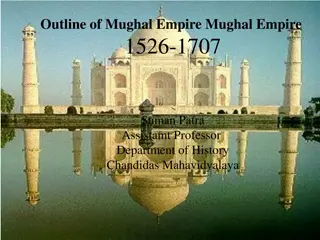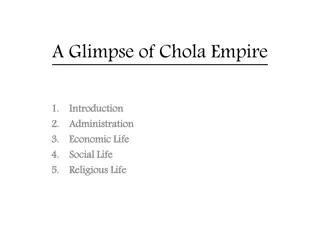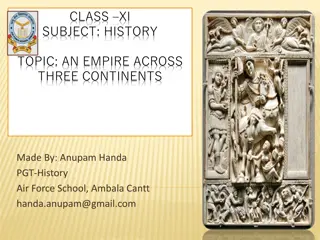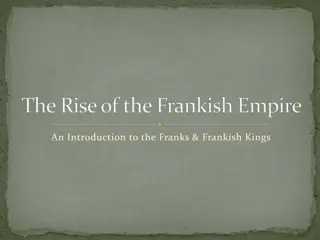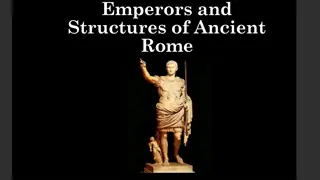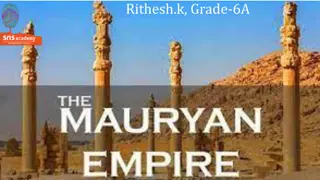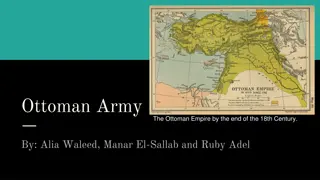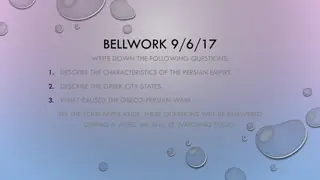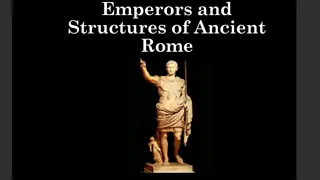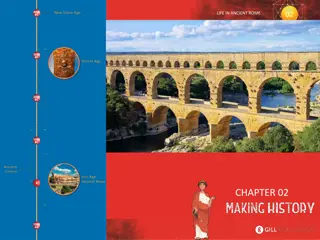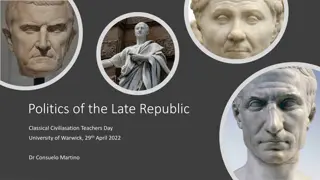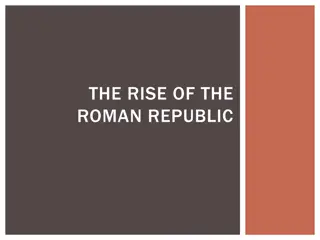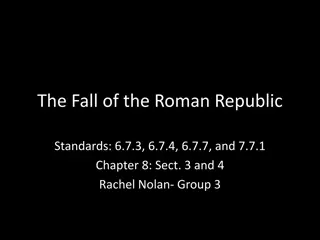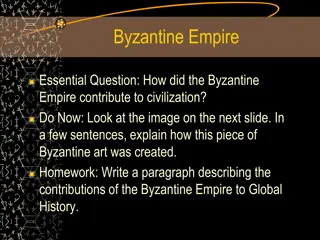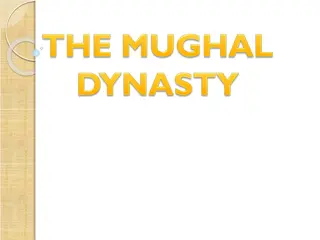The Rise of Rome: From Republic to Empire
Explore the ancient origins of Rome, from the legends of Romulus and Remus to the strategic locations that helped Rome flourish. Discover how Rome's founding paved the way for a vast empire that extended its rule across Europe, Africa, and Asia.
Download Presentation

Please find below an Image/Link to download the presentation.
The content on the website is provided AS IS for your information and personal use only. It may not be sold, licensed, or shared on other websites without obtaining consent from the author.If you encounter any issues during the download, it is possible that the publisher has removed the file from their server.
You are allowed to download the files provided on this website for personal or commercial use, subject to the condition that they are used lawfully. All files are the property of their respective owners.
The content on the website is provided AS IS for your information and personal use only. It may not be sold, licensed, or shared on other websites without obtaining consent from the author.
E N D
Presentation Transcript
Happy Tuesday!!! You will need: 1. your outline 2. something to write with
Chapter 11 Rome: Republic to Empire
Lesson 11.1 -- The Founding of Rome I. The Beginning of Rome The Romans learned from surrounding civilizations and used their new knowledge to build a vast and powerful empire. Roman rule extended throughout much of Europe, Africa, and Asia.
A. The Settling of Italy 1. Italy is centrally located in the Mediterranean region. People can easily travel to it from Africa, Asia and Europe. Mountain passes also linked settlements together. 2. Italy has a sunny, mild climate, fertile farmland, and large flat plains good for growing crops. It could support a large population.
B. Rome's Locations 1. The long, thin Italian peninsula juts out from central Europe into the Mediterranean Sea. The rugged Alps separate Italy from northern Europe, and the Apennines Mountains extend from north to south in Italy. 2. People of ancient Rome used the Tiber River to move goods easily between northern and southern Italy. The city of Rome was far enough up the Tiber to escape pirate raids.
C. Rome's Origins 1. Several different legends describe how Rome began. One is contained in The Aeneid, written by the Roman poet Virgil, where he describes what took place after the Greeks captured the city of Troy.
C. Rome's Origins 2. Another legend tells the story of Romulus and Remus, twin brothers left beside the Tiber River who were discovered by a female wolf, then raised by a shepherd and his wife. a. When they grew up, the boys argued about the construction of the city they planned to build on the Tiber River. Eventually, it is said that Remus was killed and that Romulus became the sole ruler and called the city of Rome after himself.
C. Rome's Origins 3. Archaeological artifacts suggest that Neolithic people might have settled in Italy as early as 5000 B.C. 4. Latin-speaking people, called Latins, settled on the plain of Latium in central Italy. One group of Latins build straw- roofed huts on Rome's hills, tended animals and grew crops -- these people became known as Romans.
D. Influences of Greeks and Etruscans 1. After 800 B.C., other groups moved into the region where the Romans lived, including the Greeks and the Etruscans. These groups would greatly influence Roman civilization. 2. The Greeks introduced grape and olive farming in the regions. They also passed on the Greek alphabet to the Romans.
D. Influences of Greeks and Etruscans 3. The Etruscans had an even greater influence on Roman civilization. They taught Romans to build with brick and to roof their homes with tiles. They drained the water from the marshes between Rome's hills, laid out city streets, build temples and even influenced the style of clothing the Romans wore. Finally, the Etruscan army served as the model for the might army that the Romans would eventually create.
II. Becoming a Republic A. In 509 B.C., the Romans overthrew Tarquin the Proud, the Etruscan king, and established a republic -- a form of government in which citizens elect their leaders. 1. Over the next 200 years, the Romans fought many wars against their neighbors and eventually conquered almost all of Italy. The Republic was able to acquire land because of its strong army. 2. Every male citizen who owned land had to serve in the army; Roman soldiers were well trained; deserters were punished by death.
II. Becoming a Republic 3. The Romans also developed new battle strategies: Rows of soldiers moved in a single large group; they attacked from only one direction; they organized soldier into smaller groups called legions, who were able to move quickly around the battlefield.
II. Becoming a Republic 4. Roman soldiers were well armed, most carrying a short, double-edged iron sword called a gladius and an iron spear called a pilum.
B. Who Ruled Rome? 1. After they conquered a region, the Romans build permanent military outposts to protect it. They also built roads between settlements. 2. The Romans stressed the need to treat conquered people fairly and therefore created the Roman Confederation. This system gave some conquered peoples full Roman citizenship.
B. Who Ruled Rome? 3. Other conquered peoples became allies, or friends, of Rome. 4. With these policies, Romans hoped to maintain peace in their conquered lands. This generosity paid off and the republic grew stronger and more unified.
Lesson 11.2 -- Rome as a Republic I. Governing Rome Rome's government reflected divisions within its society. Early Romans were divided into two classes: patricians and plebeians. 1. Patricians, the ruling class, were wealthy landowners that came from Rome's oldest and most prominent families. 2. Most Romans were plebeians, who were not as wealthy as the patricians, and included artisans, shopkeepers, and small-farm owners.
I. Governing Rome 3. Both patrician and plebeian men were Roman citizens and had the right to vote. Both groups paid taxes and served in the army. Plebeians, however, had a lower social position than that of patricians. 4. Rome's republic was shaped by a struggle between the patricians and the plebeians over the right to govern.
A. Government of the Republic 1. The government of the Roman Republic was organized into three branches: one branch made laws, another ran daily affairs and a third acted as judges. The republic had a system of checks and balances. The republic had a system of checks and balances. 2. Two patrician consuls headed the government and were administrators and army leaders. Each consul could veto, or reject, the other's decision.
A. Government of the Republic 3. Rome also had major government officials called praetors who interpreted the law, served as judges in court, and could lead armies. 4. The Senate, Rome's legislature, was a group of 300 patrician men, each of whom served the republic for life. By the 200s B.C. Senators debated foreign policy, proposed laws, and approved the construction of roads and temples.
B. Conflict Between Classes 1. Over time, plebeians grew frustrated because they had to serve in the army and pay taxes, but they had no power in the government. 2. The patricians allowed the plebeians to have their own body of representatives called the Council of Plebs. This council elected official called tribunes who voiced plebeian concerns to the government. Tribunes could also veto government decisions. 3. In 287 B.C., the council was given the right to pass laws for all Romans. Now, the republic was more representative, but it was still not democratic.
C. Cincinnatus and Civic Duty 1. To lead Rome, the Romans created the office of dictator, so that during a crisis the dictator had complete control over Rome. It was thought that after the crisis, the dictator would give up his power and the regular government's power would be restored.
C. Cincinnatus and Civic Duty 2. One of the most famous Roman dictators was Cincinnatus, who upon accepting the role of dictator immediately created an army. The, he led the army into battle, defeated the enemy, marched them back to Rome and resigned as dictator ... all only 16 days after taking control of the republic. 3. He was widely admired because he fulfilled his civic duty -- the idea that citizens have a responsibility to help their country. This idea was important to the Romans and has been valued by other people aw w3ell, like George Washington.
D. Rome's System of Law 1. Roman law has influenced legal systems of the United States and other countries. 2. Rome adopted its first written code of laws know as the Twelve Tables in 451 B.C. These laws served as the foundation for all future Roman laws and supported the ideal that all free citizens had the right to be treated equally in the Roman legal system. 3. As the Romans conquered more people, they created laws that would apply to people who were not Roman citizens -- these became know as the Law of Nations and applied to all people everywhere in the Roman lands.
E. Roman Justice 1. The ideas found in Roman laws are woven throughout the American legal system today. 2. The rule of law is one of the key ideas that the Romans passed on to the world, meaning that laws apply to everyone equally and that the legal system should treat everyone the same way. 3. The Romans extended the idea of the rule of law to all their lands. Today, the rule of law is the guiding principle of the American legal system.
II. The Punic Wars Carthage, a powerful trading empire based along the North African coast, became Rome's main rival. 1. Both Carthage and Rome wanted to control the entire Mediterranean world. this rivalry grew into a series of wars that took place over a period o nearly 120 years.
A. The Punic Wars Begin 1. The First Punic War began when Rome sought control of the fertile island of Sicily. Carthage used its strong navy to protect is trading kingdom. Rome, although they had a powerful arms, did not have a navy. It was forced to build a fleet to fight Carthage. 2. In 241 B.C., a Roman fleet badly defeated Carthage's navy off the coast of Sicily and Carthage was forced to give up Sicily and pay a huge fine to the Romans.
B. Hannibal Attacks: The Second Punic Wars 1. When Carthage tried to expand its empire into Spain, the Romans bitterly opposed their attempt to establish territory so near to Rome. 2. The Romans encouraged the Spanish to rebel against Carthage, so Carthage sent Hannibal, it's greatest general, to attack Rome. This started the Second Punic War.
B. Hannibal Attacks: The Second Punic Wars 3. Hannibal gathered an army, including 37 elephants, marched through Gaul before crossing the Alps into Italy. The bitter cold and attacks by mountain tribes killed almost half of the Carthaginian soldiers and most of the elephants. But the remaining army pushed on. 4. Although Hannibal defeated the Romans at the Battle of Cannae, the Carthaginians were defeated at the Battle of Zama and were forced to give up tis navy and pay Rome a large sum of money. 5. Rome became the supreme power in the western Mediterranean.
C. The Third Punic War Still considering Carthage as a military threat, Rome finally destroyed it in the Third Punic War. At the same time, Rome took control of the eastern Mediterranean region and eventually acquired its first province in Asia.


